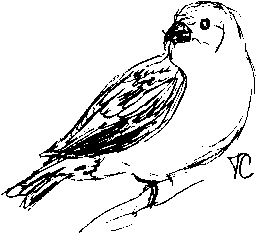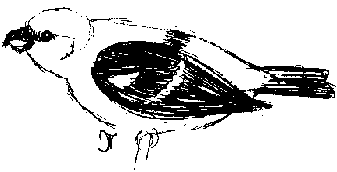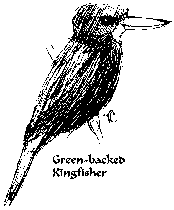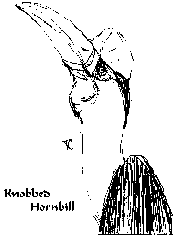

Back to Table of Contents


by Steve Sanford
A glorious event for Maryland birding happened around Christmas, 1997, and may be continuing as you read this. We have been "invaded" by crossbills - both Red Crossbills and White-winged Crossbills. These colorful birds with their unusual crossed bills normally reside somewhere near, or north of, the Canadian border, or in the Rockies and far-northwestern states and provinces
Crossbills' main food is nuts from the cones of pines and other evergreens. Their bills are designed to penetrate cones to get at the nuts. This winter the crop of cones on white pines and other conifers in the mid-Atlantic has been remarkably rich. Some crossbills apparently found that the cone crop down here was better than up north, so they invaded Maryland and vicinity, for the first time since the mid 1970s.
One of the first hints of this impending invasion was the appearance of many Red-breasted Nuthatches in our area as early as late August, with our Liberty Lake field trip on August 26 as an example. This species is often associated with a "winter finch" invasion. Starting in November, both crossbill species were being seen repeatedly at Cape Henlopen, Delaware, and here-and-there in other mid-Atlantic locations.
On December 16 Gene Scarpulla was going out to check the mail at his rustic "Reservoir Natural Resources Office" amidst the pines at the end of Oakland Road on the west side of Liberty Lake. He heard some finch-like sounds, but realized they were not any of the familiar local finches. Soon he confirmed that they were ... Red Crossbills! Over the next week or two there were repeated sightings of Red Crossbills and occasional White-winged Crossbills there. Birders came to the area from far and wide to see them. Soon, on December 23, Marshall Iliff discovered flocks of both crossbill species in greater numbers a few miles north on the west side of Liberty Lake along Deer Park Road. Soon more were discovered along Pine Knob Rd in the same area. They thrilled many birders there throughout the Christmas holiday period.
But the west side of Liberty Lake is in Carroll County. Rick Blom brought Baltimore County into the crossbill camp by finding both species of crossbills at Pine Ridge Golf Course off Dulaney Valley Road north of Towson. Other birders soon found them there too, and added them to their Baltimore County lists. White-winged Crossbills were also found near Prettyboy reservoir. Both species were also found repeatedly at Broad Creek Boy Scout Camp in Harford County.
We hope this invasion will continue all winter. As of mid-January it is still going strong. Check the Baltimore Birdline (410-467-0653, or on the Internet at http://www.bcpl.lib.md.us/~tross/birdline.html. Another good source of information is the new MD Osprey mailing list on the Internet which can be viewed at http://www.ari.net/mdosprey/. And, of course, watch your yards and feeders, especially if you have pine trees. If you see any crossbills, or any other notable birds, be sure to report them to the Baltimore Birdline at 410-467-0653.
Art note: Thanks to Tim Carney for providing the bird drawings for the crossbill article, and the Postcard from Sulawesi.
Back to Table of Contents
by Gail Frantz
Hart-Miller Island is a 13 year-old, 1100-acre island created when the highly eroded Hart Island and Miller Island were connected by a 6-mile long perimeter dike. The interior cells of the dike are being filled with dredged material obtained from the Port of Baltimore and some portions of the Baltimore and Chesapeake Bay navigation channels. The island is divided into two cells: he North Cell, which will be used for dredged material placement until the year 2009, and the completed 300-acre South Cell, which is the area currently under consideration. Over the years, many ideas have emerged to develop the island, ranging from a golf course to an amusement park to a wooded tract. The most recent proposal is a wildlife habitat with passive (non-invasive) use by citizens.
The decision how the South Cell area will be developed is now in the home stretch. All Baltimore County citizens, but birders in particular, have the unprecedented opportunity to influence the establishment of a migrating shorebird and nesting tern habitat on Hart-Miller Island. As one birder put it, "we'll never have another chance like this."
The Folks Who Care
In December 1997, the second public workshop was held at the Chesapeake High School in Essex. Participants included Baltimore County citizens, elected officials from Baltimore County, the Hart-Miller Island Study Team and Michael Baker Jr., Inc., an environmental engineering consulting firm that put together an informative display depicting the various proposals that are on the table. The purposes of the workshop were to update the public and to continue receiving input from involved citizens. The issue was whether to develop Hart-Miller as habitat for migrating shorebirds and nesting terns.
Proposals Under Consideration
Presently, the three main proposals are
Maryland Ornithological Society Bird Surveys
Over the last thirteen years, much migratory information about 267 species has been recorded by Maryland Ornithological Society members. Gene Scarpulla currently conducts weekly bird surveys on Hart-Miller Island and also represents MOS on the Study Team.
At the December public workshop, Gene pointed out that in addition to the fascinating birding opportunities that Hart-Miller would afford us as birders, there could also be exciting educational opportunities for Maryland schoolchildren. In addition, Gene's weekly monitoring of the island will undoubtedly continue to reveal hitherto unknown migratory patterns.
Who Pays For All This?
The Federal Government and the State of Maryland will share the cost. After the restoration work is completed, the state will be responsible for operating and maintaining the restored facility.
Begin Voicing Your Support Now
The next meeting in March is critical. The plans will be finalized very soon after that. Only your endorsement of the number 2, the Wetland/Shorebirds Bird Concept will make this extraordinary birding wetland happen. Fran Saunders from MOS writes, "We urge you to send your comments as soon as possible, since the draft report is expected to be released for public review and comment in January or February 1998."
How To Help
e-mail your support to:
Back to Table of Contents
North Point State Park, which includes Black Marsh Wildlands, is looking for volunteers to lead occasional morning bird walks at the park. Walks are generally scheduled to last two hours. Participants on the walks are usually beginning bird watchers. This is an excellent opportunity to hand out BBC membership information and attract new members to the club. For further information or to volunteer, please contact Ranger Michael Lathroum at (410) 477-0757.
Back to Table of Contents
by Alan Bromberg, Recording Secretary
The Board of Directors met on November 10 and December 8. At the November meeting, the board heard a report on the first Gwynns Falls bird survey, in which all BBC members are encouraged to participate. The next survey will be part of the Mid-Winter count. The board discussed production of the maps for the site guide and a proposed effort by the city to improve the image of Cylburn. Complaints that the BBC Birdline was not updated every week were noted. Updates depend on receipt of reports. Reports, as well as questions about the BBC, have been sporadic. The board discussed whether to continue the Birdline and how to obtain additional information on bird sightings.
At the December meeting, the board approved a change to the by-laws providing that former BBC presidents be members of the board. The change is shown below and will be presented to the membership for a vote at the annual meeting in March. The board further discussed the production of maps and other issues related to publication of the site guide. A group has been formed to glean rare bird alerts on the Internet in order to provide more information on sightings in Maryland and nearby areas for the Birdline. The board heard a report on a meeting held on December 2 concerning the future of Hart-Miller Island. BBC members are urged to write letters in support of preserving the south cell of the island as a habitat for migrating shore birds.
Back to Table of Contents
Add to Article VI Section 1, (6) The Immediate Past President.
The article will read as follows:
Section 1. The Board of directors shall consist of
Back to Table of Contents

This is a reminder that we do have a Baltimore birding hotline, and we need your reports.
Let us hear about your sightings. Naturally we want to hear about uncommon birds and "rarities." But also let us know about highlights of your birding in the region, as well as interesting yard birds, seasonal arrivals, and nesting. We urge field trip leaders especially to report trip highlights directly to the BirdLine in addition to mailing in your reports. You can call in your sightings to (410) 467-0653. You can also e-mail your sightings to the BirdLine at . For best results, please include the specific words: "BBC BirdLine Sighting" on the subject line.
Back to Table of Contents
by Hank Kaestner
 12 November 1997
12 November 1997
Dear Chippers,
I have traveled to
SE Asia to do a crop survey on Indonesian vanilla. A visit last week to
the major production area in northern Sulawesi Island revealed that the
El Niño-induced draught has killed more than 50% of the vanilla
 vines. Large numbers of clove trees have also died. For a birder Sulawesi
ris a paradise, with over 100 endemic species in the
egion, many very unusual and brightly plumaged. I was able to spend a
free Sunday in Tangkoko Park, a large part of which had been burned by
fire, but still managed to see 10 lifers including the rare Green-backed
Kingfisher. One of the highlights of Tangkoko is the world's densest
population of hornbills. We saw hundreds of the large, gaudy Knobbed
Hornbill. We did very well on "night" birds, including a great daytime
view of the seldom-seen Minahassa Owl (a forest barn owl), the Ochre-bellied
Hawk-Owl, and the Sulawesi Scops Owl.
vines. Large numbers of clove trees have also died. For a birder Sulawesi
ris a paradise, with over 100 endemic species in the
egion, many very unusual and brightly plumaged. I was able to spend a
free Sunday in Tangkoko Park, a large part of which had been burned by
fire, but still managed to see 10 lifers including the rare Green-backed
Kingfisher. One of the highlights of Tangkoko is the world's densest
population of hornbills. We saw hundreds of the large, gaudy Knobbed
Hornbill. We did very well on "night" birds, including a great daytime
view of the seldom-seen Minahassa Owl (a forest barn owl), the Ochre-bellied
Hawk-Owl, and the Sulawesi Scops Owl.
Best,
Hank Kaestner, from over the edge.
Back to Table of Contents
compiled by Steve Sanford
November 15 - Piney Run. Predictions of rain apparently frightened off all but three participants. The weather was actually dry, mostly cloudy, and in the 40s. There were 11 species of waterfowl, and a total of 39 species. Flocks of perhaps several hundred Cedar Waxwings periodically landed in the trees and appeared to replace the recently fallen leaves. The group missed a Bald Eagle that was seen there a little later. Leader: Burton Alexander.
November 29 - Blackwater NWR. No report received, but we hear some participants saw a King Eider in the Choptank River at Cambridge.
December 6 - Southern
Maryland. The trip was almost canceled due to the prediction of high
winds and temperatures only in the thirties. The wind and cold were actually
much less of a problem than anticipated.
The 12 participants had excellent looks at all three Scoter species at the fishing pier at Point Lookout State Park, with Surf Scoters most abundant, followed by White-winged and Black. Oldsquaw and loons were less numerous than usual, and grebes were strangely absent. One distant Gannet was spotted. There was a very close Purple Sandpiper on the small jetty east of the southernmost parking area.
Land birds were rather scarce. The group did not find any Brown-headed Nuthatches at Point Lookout for the first time in years on this trip. The Beauvue ponds near Leonardtown had far less waterfowl than in previous years, and no Meadowlarks or Short-eared Owls. Battle Creek Cypress Swamp (Calvert County) was unusually inactive, but the interesting visitor center was cozy as always. Schoolhouse Pond (Upper Marlboro) produced some Shovelers, Gadwall, and Swamp Sparrows.
The trip had 64 species. Leader: Steve Sanford.
Back to Table of Contents
by Hank Kaestner
Dear Chippers,
This is a card from over the edge.
This is the most isolated and primitive place I've ever visited. I've just spent a week on New Britain Island in Papua, New Guinea. I was looking for, and found, lots of vanilla being grown by the native Melanesians.
Although the bird life is not as diverse as on mainland New Guinea, the birds that are here are unique, with many endemics. My favorite has been the Blue-eyed Cockatoo. Also beautiful are the various lorikeets, imperial pigeons, fruit-doves, honeyeaters, etc.
Hank Kaestner
Back to Table of Contents
 Back Yard Birding
Back Yard Birdingby
Steve Sanford forwarded this message from Harford County’s Les Eastman, Nov. 11:
Between chores at home today, I have been keeping an eye on the feeder (also putting out the winter complement of feeders) and I had a short visit by 5 Pine Siskins. Purple Finches have been reliable (outnumbering the House Finches on Sunday), and Saturday I had at least 2 Evening Grosbeaks, so the winter finches are here. Now, where are the Crossbills?The news about his winter finches is tantalizing!" Steve wrote. "I've seen a few other indications on the Internet of winter finches in the area, too. Unfortunately not in my yard, though. How about yours?"
Happily, White-winged and Red Crossbills did turn up at Liberty Lake and other central Maryland locations in December (see "Crossbill Invasion" above). Baltimore County Suburbs
This is one of my best years. The total count for September 4 to October 31 is 4,939 hawks. The Broad-winged Hawks rated the highest count: 4,324. The single highest count in one minute was 1,047 on Sept. 15! Interesting hawks include a Golden Eagle on Oct. 13 and Oct. 21. Then a N. Goshawk on Oct. 28.
Species Count for Sep. 4 to Oct. 31:
244 Turkey Vultures
98 Red-tailed Hawks
7 Rough-legged Hawks
20 Ospreys
21 Am. Kestrels
5 Merlins
1 Peregrine Falcon
7 Unidentified Raptors
6 Black Vultures
2 Golden Eagles
9 Bald Eagles
34 Red-shouldered Hawks
89 Sharp-shinned Hawk
61 Cooper's Hawks
1 N. Goshawk
4324 Broad-winged HawksOther birds seen during migration: 16 Cattle Egrets on Sept. 6, 4 Double-crested Cormorants on Oct. 16. Canada Geese numbered 1,347 on Oct. 1 and on Oct. 16, 1,483.
During hawk migration, my yard has been under attack by hungry Sharp-shinned and Cooper's Hawks. They caught a total of 3 House Sparrows, 1 House Finch, 1 Blue Jay and 1 mouse from the garden and feeder. After 3 years of unsuccessful hunting, this is the first time I've seen the hawks finally catch some lunch.
Oct. 27, the Juncos came back. I also observed a Yellow-bellied Sapsucker searching for food on several trees. My first Ruby-crowned Kinglet is a welcome new bird on my backyard list. On November 1 a Carolina Wren was checking out the nest box on our back porch.
During the week of Nov. 11 Kevin's yard hosted a White-breasted Nuthatch, increasing numbers of Juncos and Am. Goldfinch, Purple Finch and a Fox Sparrow. Country
The Upside Down feeder costs about $18 to $20. The Soda Bottle Feeder costs about $10.
On Nov. 11 at the Johns Hopkins Univ. Space Telescope Science Institute, Terry Ross gave a marvelous lecture which he called Birding and the Internet. The arrangements to use that awesome facility with its enormous screen hooked up to a computer were made by Shireen Gonzaga, a gracious BBC member who works there. Terry gave us a comprehensive and oftentimes humorous computer-user view of the birdwatching action that's happening on the net. He walked us through many available sources which he has linked from his BBC web page. In addition he gave us tips for "sailing" out on our own. Terry keeps records of the number of "hits" that his pages get (tens of thousands!) He also keeps a record of the number of countries heard from. Words most often heard from the audience were "incredible" and "unbelievable." Try it, you'll love it. (GF)
Let us hear about your Back Yard birding too. Call or write
Back to Table of Contents
by Louise Snyder
My backyard on Edmondson Avenue doesn't attract many interesting birds - mostly sparrows and pigeons. But once in a while I'm treated to something exciting.
Glancing out the dining room window last Thanksgiving day, I saw something at the edge of the driveway. At first I thought it was some dry leaves. Looking closer it was a bird resting on the ground no more than eight feet from the house, facing the window. It sat there motionless except for the head which turned to the left than to the right and then straight ahead as if staring at me.
It had an owl-like face, white, heavily streaked breast and something white near the tip of its folded wing, and with binoculars I could see that it was feathers. It had yellow eyes, a pale eyebrow and a small white patch just above the nostrils. I ran to the second floor and looked down and realized it was a large chestnut colored bird, with a very long tail that had alternating bands of light and dark Back to the dining room. After about fifteen minutes, it stretched a little and extended a bright yellow leg and than slowly retracted it.
Another thirty minutes went by and it still sat there. Could it be injured or sick and can't fly? Another ten minutes went by and to my surprise it stood on both legs and slowly turned around. I was relieved to see that it didn't appear injured. With one eye on the bird and the other searching through bird books, I'm pretty sure it was a female Northern Harrier. As I watched, she fluttered her wings slightly, and then with great energy and speed she took to the sky and was out of sight in less than two seconds. The next hour I spent comparing my notes with descriptions in my books, The white rump feathers convinced me that it really was a Northern Harrier.
Could I be wrong?
Back to Table of Contents
To Baltimore Bird Club Home
Page